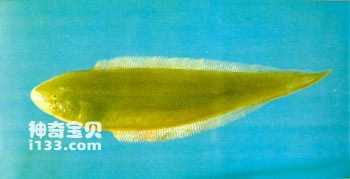The narrow-bodied tongue sole (Cynoglossus gracilis) belongs to the order Cynoglossus, the family Cynoglossus, and the genus Cynoglossus. Commonly known as: tongue sole, flatfish. English name: Narrow tonguesole.
The body is narrow, long and flat, shaped like a tongue. The head is short and small, and the head length is slightly longer than the head height. The snout is long and blunt at the tip. The mouth is small, the cleft is arched, and the corner of the mouth reaches below or behind the posterior edge of the lower eye. The two jaws on the eye side have no teeth; the two jaws on the eyeless side have villous fine teeth arranged in a band. The eyes are very small and very close to each other, both on the left side of the body. The posterior edge of the anterior gill cover is not free; the gill opening is narrow, the left and right gill membranes are healed and are not connected to the isthmus; the gill rakers are degenerated. The anus is deviated, located on the eyeless side. The scales on both sides of the body are small, and the scales on the side with eyes are slightly larger than the scales on the side without eyes. The side with eyes has three lateral lines; the side without eyes has no lateral lines. The bases of the dorsal fin and anal fin are both very long, and the number of fin rays is extremely large, all of which are unbranched and connected to the caudal fin respectively. The dorsal fin begins above the tip of the snout; the anal fin begins below the gill opening. No pectoral fins. The pelvic fin is connected to the anal fin on the eye side; there is no pelvic fin on the eyeless side. Caudal fin pointed. The side with eyes is grey-brown, and the side without eyes is white; the color of the side with eyes can change with the color of the substrate in the living environment.

It lives a benthic life and has migratory habits. It has strong adaptability to changes in salinity in the water environment. It is more common in brackish water in river estuaries, and sometimes lives in fresh water. Juveniles with a body length of less than 13 centimeters feed solely on crustaceans, while adults are omnivorous, feeding mainly on snails, mussels, shrimps, and clams, followed by fish eggs and plant debris. The spawning season is in April. The smallest sexually mature female fish has a body length of 19.6 cm and a weight of 27 grams.
Distributed in the brackish water areas along my country's coast and in the estuaries of rivers and seas, it also enters the middle and lower reaches of rivers. It is one of the common edible fish in estuary areas and has certain economic value.
There is another species of tongue sole - C. trigrammus - in the brackish water areas and middle and lower reaches of coastal estuaries in my country. It is very similar to the narrow-bodied tongue sole. The main differences are: the corner of the mouth reaches the center or slightly below the lower eye; there are several irregular brown spots on the left side of the head and body. Its living habits and distribution are also the same as those of the narrow-bodied tongue sole.
animal tags:
We created this article in conjunction with AI technology, then made sure it was fact-checked and edited by a Animals Top editor.